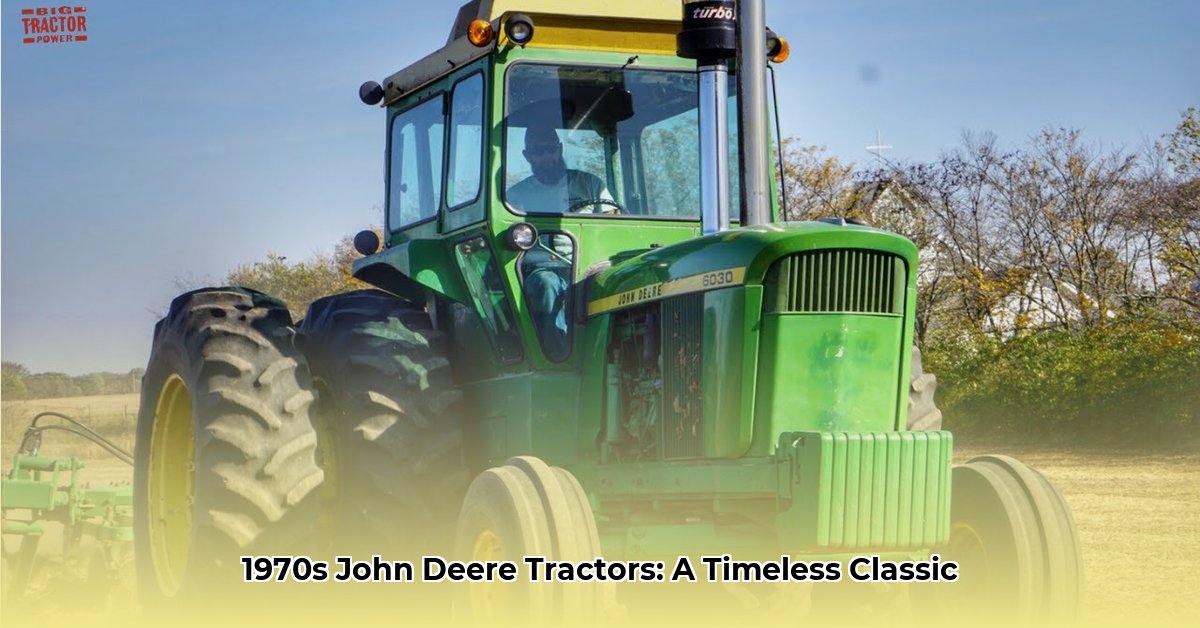
1970s John Deere Tractors: A Decade of Farming Revolution
The 1970s witnessed a seismic shift in agriculture. Farms expanded, demanding more powerful and efficient machinery. John Deere answered this call with its revolutionary Generation II tractors, marking a pivotal moment in farming history. This era saw advancements in horsepower, operator comfort, and overall machine efficiency, shaping the future of agricultural technology. But how did John Deere accomplish this monumental leap forward? For more detailed information on specific models, check out this helpful resource: John Deere Manuals.
The Farm Scene in the Early 1970s: A Landscape Ready for Change
The early 1970s found American agriculture on the brink of transformation. Larger farms were becoming prevalent, requiring equipment capable of handling increased workload and acreage. Farmers increasingly embraced advanced techniques and efficient practices, demanding more capable machinery. This created a fertile ground for innovation, perfectly setting the scene for John Deere's impact. Wasn't this technological shift crucial to the industry's evolution?
John Deere's Generation II: A Game-Changing Tractor Series
John Deere's response was the Generation II series, debuting in 1972. This wasn’t a mere upgrade, but a complete redesign. The most striking feature was the "Sound Guard" cab, dramatically reducing noise levels and improving operator comfort. This innovation significantly enhanced the long-term health and well-being of farmers. However, it was only one of the many innovations within a range of models designed to meet the growing needs of diverse farming operations.
Power and Choice: Expanding Horsepower Options for Farmers
John Deere significantly expanded the horsepower range of its offerings. From smaller, versatile models suitable for smaller farms to robust, four-wheel-drive tractors for large-scale operations, there was a John Deere tractor to meet almost any farming need. This diversification was a defining characteristic of the Generation II series, ensuring farmers had access to equipment optimally matched to their operations. How crucial was this expansion to the adoption of the Generation II line?
The Generation II Family: Model Variety and Technological Refinements
The Generation II wasn't a single tractor but a range of models, each with strengths tailored to specific tasks. The 4020, 4440, and 4640, for example, offered varying horsepower and capabilities. These tractors continually evolved year after year, incorporating refinements in design, performance, and reliability. This ongoing improvement reflects John Deere's commitment to meeting the ever-evolving needs of farmers.
| Model | Approximate Horsepower | Notable Features |
|---|---|---|
| 4020 | ~80 | Versatile, cost-effective, incredibly popular |
| 4440 | ~100 | Increased power, enhanced efficiency |
| 4640 | ~120 | High power designed for heavy-duty implements |
| 4030 | ~65 | Compact and perfect for smaller farms |
Compact Diesels: Meeting the Needs of Smaller Farms
Recognizing the needs of smaller farms, John Deere introduced compact diesel tractors in 1977. These tractors emphasized fuel efficiency and maneuverability, broadening the appeal of John Deere equipment to a wider range of farming operations. This strategic move showcased the company's ongoing commitment to providing tailored solutions for its diverse customer base.
The Enduring Legacy: Generation II's Impact on Farming
The Generation II tractors redefined agricultural standards. They set new benchmarks in safety, comfort, and power, fundamentally altering farming practices and enabling the growth of larger-scale operations. Their lasting impact continues to be felt today, with many of these machines still in use and highly valued by collectors.
"The Generation II tractors were a significant step forward, not just in technology, but in how farmers interacted with their equipment," says Dr. Amelia Hernandez, Agricultural Historian at the National Agricultural Museum. "They represent a turning point between traditional farming and modern agricultural practices."
Collecting and Maintaining a Piece of History
Owning and restoring a Generation II tractor is a rewarding endeavor for collectors. While sourcing original parts can be challenging (with many parts now considered rare or obsolete), the inherent value of these historically significant machines is widely recognized.
How to Identify Rare John Deere 1970s Tractor Configurations
Key Takeaways:
- The 1970s marked a significant era of innovation in John Deere tractor production.
- Identifying rare configurations requires detailed analysis of model variations, unique options, and production records.
- Collectors prize originality and well-preserved tractors, making careful examination essential.
Spotting the Standouts: Identifying Rare Configurations
Locating a rare 1970s John Deere tractor requires diligent research. Here's a breakdown of key identification methods:
- Serial Numbers: The serial number, often found on a data plate, is crucial for pinpointing the model, year, and sometimes even specific options.
- Decals and Paint: Original decals and paint are highly valued. Any discrepancies might indicate modifications or repainting. The original color and the presence of all original decals are crucial for determining a tractor’s potential value.
- Unique Options and Features: Look for specialized features like the "Sound Guard" cab or unique PTO setups. These features often signal limited production runs or special order specifications.
- Engine and Transmission: Even minor variations in engine block numbers or transmission components can indicate rarity.
- Condition and Documentation: A well-preserved tractor with supporting documentation increases its value significantly.
Delving Deeper: Verifying Rarity
Once a potentially rare tractor is found, further verification is crucial. This involves:
- Consulting John Deere Resources: Although access may be limited, John Deere's archives could contain valuable production data.
- Connecting with Collectors: Online forums and collector communities are invaluable resources for comparing findings and obtaining expert opinions.
- Analyzing Sales Data: Auction results and dealer listings offer insights into market values for comparable tractors.
The Collector's Market: A Passion for History
Collectors prioritize originality. A tractor with all original components is highly sought after. Note that finding replacement parts for rare configurations can be expensive and time-consuming, adding to the challenge and rewarding nature of collecting.